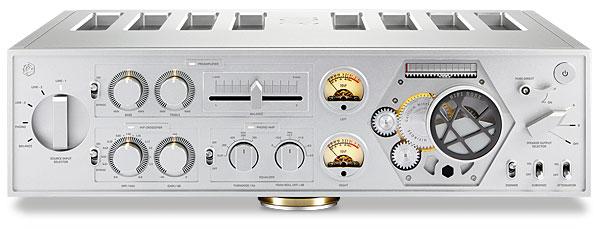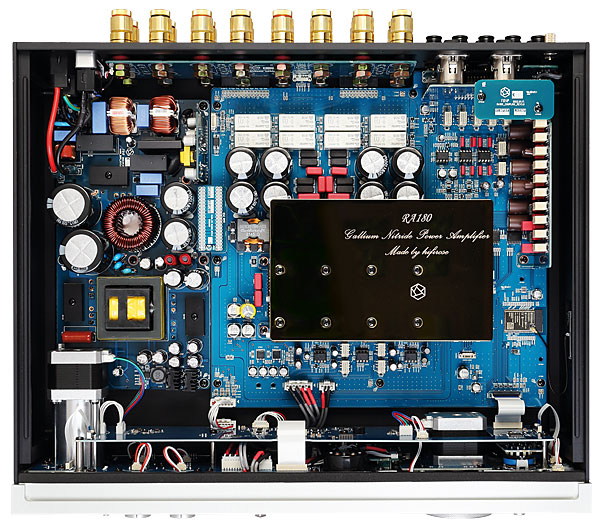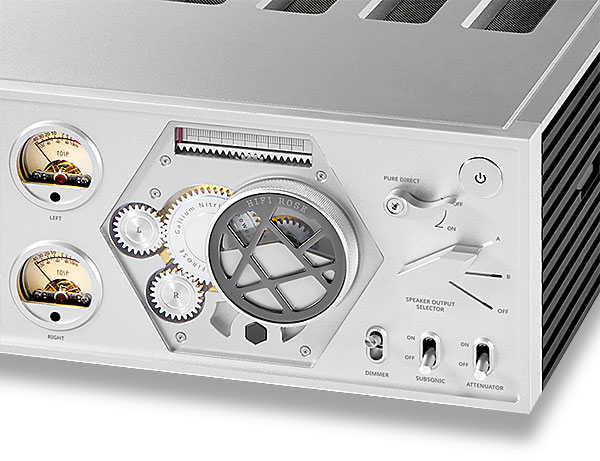HiFi Rose RA180 Integrated Amplifier

 Steampunk styling meets luxury audio as the masters of touchscreen streaming launch one of the most tactile and flexible all-analogue integrated amplifiers ever seen!
Steampunk styling meets luxury audio as the masters of touchscreen streaming launch one of the most tactile and flexible all-analogue integrated amplifiers ever seen!
Say what you will about HiFi Rose, the fledgling brand hailing from Seoul in South Korea, it sure knows how to capture the attention of audiophiles. First by launching remarkable do-it-all streaming players featuring huge touchscreens and options galore, and now this 'steampunk' integrated amp which left Internet forums speechless for about 15 seconds. Quite an achievement in this day and age... and those pundits hadn't yet seen the baffling rear of the RA180 with its sixteen loudspeaker terminals!
But unlikely as it seems, the slick RS150 network player [HFN Jun '21], with its massive 14in display, and this brand-new all-analogue RA180 amplifier both share a common denominator. The giveaway is the seventeen buttons, knobs, and sliders on the front fascia, together with some VU meters and cogs thrown in for good measure. Whatever industrial design eccentricities HiFi Rose might embrace, the brand is all about offering a multitude of features and functions. However, with its £5500 price tag, the RA180 also marks a significant turn upmarket.
Quad, Not Quadraphonic
It's also offering something 'different' by housing no fewer than four GaN (gallium nitride) transistor-based Class D amp modules under its precision-milled bonnet [see HFN Aug '21]. The higher switching speed and power handling of these new transistors improves the linearity of HiFi Rose's homebrew modules, a claim reinforced by its invention of the term 'Class AD' operation. Class A distortion at low levels with the efficiency of Class D? That's what the creative licence would suggest.
Otherwise, the RA180's front panel includes a veritable smorgasbord of influences. There's a hint of Nagra here, with dials and controls from the golden age of hi-fi, combined as if by a Swiss watchmaker's atelier taken over by a Red Bull promotional team.
As for the volume control… turn the large and finely crafted dial and it engages a gear that moves two smaller cogs marked 'L' and 'R'. Above, there's a backlit mechanical indicator that ratchets to the right as the output increases. If you raise or lower the volume level with the remote, the whole gearing mechanism is driven by a motor and moves quite loudly. It's brazenly over-engineered.

HiFi Rose's Sean Kim references 'retro-futurism' in the RA180's appearance. This is a design movement nostalgically hailing back to a non-existent and more human-centric technology. 'Steampunk' is an expression of the movement, imagining present-day devices but powered by steam-based Babbage computers. Luckily, HiFi Rose hasn't taken it that far.
One of the tenets of retro-futurism is that advanced technology should be made more accessible and user-friendly. That's not necessarily the first impression made by the RA180, but I soon appreciated that the diversity of control types, which initially look a tad chaotic, introduces a form of organisation and divides the front panel into functional zones. We'll dive into that directly, but safe to say that if HiFi Rose had chosen to use seventeen identical knobs it would be a usability nightmare – and a lot less pleasing on the eye, too.
This might appear gimmicky, but form and fit are superb, and every aspect of the amplifier looks and feels premium. That last aspect really is important, as the RA180 offers far more of a tactile experience than its contemporaries.
As for those 'zones' on the fascia, each groups the buttons linked to a particular feature. Some are typical, such as the recessed dial for input selection on the left, and the aforementioned volume control on the right. There are tone controls too, all defeatable should you want to trim down the RA180 to its essence. In fact, you can even engage a 'pure direct' power amplifier mode, alongside warnings on the fascia about switching to full gain with a live (playing) input.
Ahead Of The Curve
Equally unusual are the RA180's controls in the zones dedicated to the phono stage and the high-pass crossover function. Both feature two dials – in different styles, of course. These phono controls will be appealing to a vanishingly small, niche market, as they allow you to dial in a variety of pre-RIAA equalisation curves. Wouldn't it have been more useful to offer variable MC loading?

The high-pass crossover function allows you to filter the output of one of each amplifier pair – there are two amplifier modules per channel in the RA180 – above 600Hz-6kHz. You might choose to use this function to limit the bandwidth of the amplifier feeding the treble arm of a bi-amped speaker, for example, or set it to the top 6kHz filter before driving a supertweeter.
A typical stereo amplifier features four loudspeaker terminals. The RA180? Sixteen, which is astonishing even if you consider the A/B speaker option (note that's an 'either', not an 'and', option, as you cannot enable the A and B pair at the same time). As previously mentioned, there are not two but four identical amplifier modules in the RA180 for a claimed total of 4x200W. But you'll only use the four together when utilising one of its specialised speaker modes, either to bi-amp a pair of speakers (two amplifiers per channel) or bridging each pair into a higher-powered stereo configuration, where the claimed output becomes a whopping 2x400W.

























































